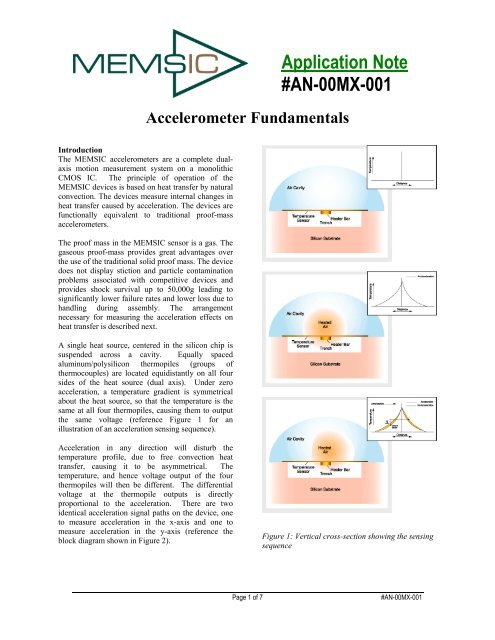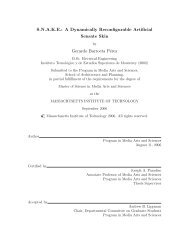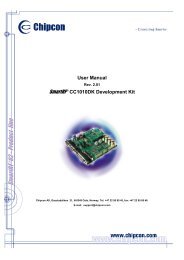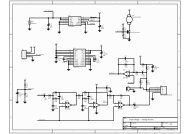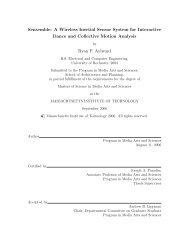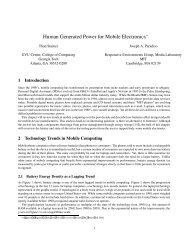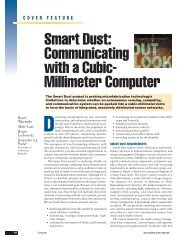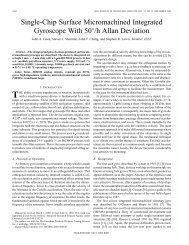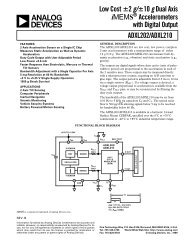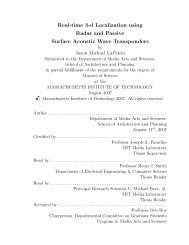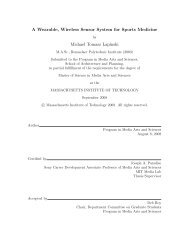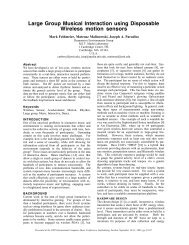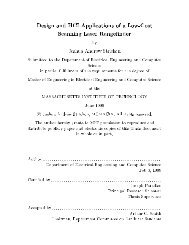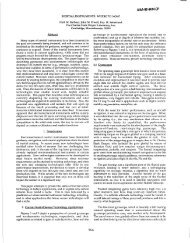Application Note #AN-00MX-001 - Responsive Environments Group
Application Note #AN-00MX-001 - Responsive Environments Group
Application Note #AN-00MX-001 - Responsive Environments Group
Create successful ePaper yourself
Turn your PDF publications into a flip-book with our unique Google optimized e-Paper software.
Introduction<br />
The MEMSIC accelerometers are a complete dualaxis<br />
motion measurement system on a monolithic<br />
CMOS IC. The principle of operation of the<br />
MEMSIC devices is based on heat transfer by natural<br />
convection. The devices measure internal changes in<br />
heat transfer caused by acceleration. The devices are<br />
functionally equivalent to traditional proof-mass<br />
accelerometers.<br />
The proof mass in the MEMSIC sensor is a gas. The<br />
gaseous proof-mass provides great advantages over<br />
the use of the traditional solid proof mass. The device<br />
does not display stiction and particle contamination<br />
problems associated with competitive devices and<br />
provides shock survival up to 50,000g leading to<br />
significantly lower failure rates and lower loss due to<br />
handling during assembly. The arrangement<br />
necessary for measuring the acceleration effects on<br />
heat transfer is described next.<br />
A single heat source, centered in the silicon chip is<br />
suspended across a cavity. Equally spaced<br />
aluminum/polysilicon thermopiles (groups of<br />
thermocouples) are located equidistantly on all four<br />
sides of the heat source (dual axis). Under zero<br />
acceleration, a temperature gradient is symmetrical<br />
about the heat source, so that the temperature is the<br />
same at all four thermopiles, causing them to output<br />
the same voltage (reference Figure 1 for an<br />
illustration of an acceleration sensing sequence).<br />
Acceleration in any direction will disturb the<br />
temperature profile, due to free convection heat<br />
transfer, causing it to be asymmetrical. The<br />
temperature, and hence voltage output of the four<br />
thermopiles will then be different. The differential<br />
voltage at the thermopile outputs is directly<br />
proportional to the acceleration. There are two<br />
identical acceleration signal paths on the device, one<br />
to measure acceleration in the x-axis and one to<br />
measure acceleration in the y-axis (reference the<br />
block diagram shown in Figure 2).<br />
<strong>Application</strong> <strong>Note</strong><br />
<strong>#AN</strong>-<strong>00MX</strong>-<strong>001</strong><br />
Accelerometer Fundamentals<br />
Figure 1: Vertical cross-section showing the sensing<br />
sequence<br />
Page 1 of 7 <strong>#AN</strong>-<strong>00MX</strong>-<strong>001</strong>
Acceleration Measurement Range and<br />
Accelerometer Outputs<br />
The MEMSIC devices are capable of measuring<br />
accelerations with a full-scale range from below ±<br />
1.0g to above ±100g. The devices can measure both<br />
dynamic acceleration (e.g. vibration) and static<br />
acceleration (e.g. gravity).<br />
The devices can provide analog or digital output<br />
voltages. Analog output voltages are available in<br />
absolute and ratiometric mode. The absolute output<br />
voltage is independent of the supply voltage, while<br />
the ratiometric output voltage is proportional to the<br />
supply voltage. The digital outputs are signals with<br />
duty cycles (ratio of pulse width to period) that vary<br />
with acceleration.<br />
The resolution, or the smallest detectable increment<br />
in acceleration is defined by the signal noise. For the<br />
MEMSIC accelerometers the typical noise floor is<br />
below 1mg/ Hz , allowing sub milli-g signals to be<br />
measured at very low frequencies.<br />
The frequency response, or the capability to measure<br />
fast changes in acceleration is defined by design. For<br />
these devices the -3dB rolloff occurs at above 30 Hz<br />
but is expandable to >160 Hz (reference <strong>Application</strong><br />
<strong>Note</strong> AN-<strong>00MX</strong>-003).<br />
Sck<br />
(optional)<br />
CLK<br />
Heater<br />
Control<br />
2-AXIS<br />
SENSOR<br />
Internal<br />
Oscillator<br />
X axis<br />
Y axis<br />
Continous<br />
Self Test<br />
Factory Adjust<br />
Offset & Gain<br />
Temperature<br />
Sensor<br />
Voltage<br />
Reference<br />
Low Pass<br />
Filter<br />
Low Pass<br />
Filter<br />
Vdd Gnd Vda<br />
Figure 2: Typical Block Diagram<br />
Tout<br />
Vref<br />
Aout X<br />
Aout Y<br />
<strong>Application</strong> <strong>Note</strong><br />
<strong>#AN</strong>-<strong>00MX</strong>-<strong>001</strong><br />
Packaging and Operating Range<br />
The accelerometers are available in a low-profile<br />
LCC surface mount package (2.00 mm height). They<br />
are hermetically sealed and are operational over a<br />
-40°C to +105°C temperature range.<br />
1<br />
2<br />
3<br />
Y +g<br />
Page 2 of 7 <strong>#AN</strong>-<strong>00MX</strong>-<strong>001</strong><br />
8<br />
MEMSIC<br />
4<br />
Top View<br />
7<br />
6<br />
5<br />
X +g<br />
Pin Description: LCC-8 Package<br />
Pin Name Description<br />
1 TOUT Temperature (Analog Voltage)<br />
2 AOUTY Y-Axis Acceleration Signal<br />
3 Gnd Ground<br />
4 VDA Analog Supply Voltage<br />
5 AOUTX X-Axis Acceleration Signal<br />
6 Vref 2.5V Reference<br />
7 Sck Optional External Clock<br />
8 VDD Digital Supply Voltage<br />
Figure 3: Sample package and pin-outs
Pin Descriptions<br />
VDD – This is the supply input for the digital circuits<br />
and the sensor heater. The DC voltage should be<br />
between 2.70 and 5. 5 volts.<br />
VDA – This is the power supply input for the analog<br />
amplifiers.<br />
Gnd – This is the ground pin.<br />
AOUTX – This pin is the output of the x-axis<br />
acceleration sensor. The user should ensure the load<br />
impedance is sufficiently high as to not source/sink<br />
>100µA typical. While the sensitivity of this axis has<br />
been programmed at the factory to be the same as the<br />
sensitivity for the y-axis, the device can be<br />
programmed for non-equal sensitivities on the x- and<br />
y-axes.<br />
AOUTY – This pin is the output of the y-axis<br />
acceleration sensor. The user should ensure the load<br />
impedance is sufficiently high as to not source/sink<br />
>100µA typical. While the sensitivity of this axis has<br />
been programmed at the factory to be the same as the<br />
sensitivity for the x-axis, the device can be<br />
programmed for non-equal sensitivities on the x- and<br />
y-axes.<br />
TOUT – This pin is the buffered output of the<br />
temperature sensor. The voltage at TOUT is an<br />
indication of the die temperature. This voltage is<br />
useful as a differential measurement of temperature<br />
from ambient and not as an absolute measurement of<br />
temperature. After correlating the voltage at TOUT to<br />
25°C ambient, the change in this voltage due to<br />
changes in the ambient temperature can be used to<br />
compensate for the drift over temperature of the<br />
accelerometer offset and sensitivity. Please refer to<br />
the section on Output Changes With Sensitivity Over<br />
Temperature for more information.<br />
Sck – The standard product is delivered with an<br />
internal clock option (800kHz). This pin should be<br />
grounded when operating with the internal clock.<br />
An external clock option, between 400kHz and<br />
1.6MHz, can be special ordered from the factory.<br />
Vref – A reference voltage is available from this pin.<br />
It is set at 2.50V typical and has 100µA of drive<br />
capability.<br />
<strong>Application</strong> <strong>Note</strong><br />
<strong>#AN</strong>-<strong>00MX</strong>-<strong>001</strong><br />
Output Sensitivity Changes with Temperature<br />
Each family of thermal accelerometer displays the<br />
same sensitivity change with temperature. The<br />
sensitivity change depends on variations in heat<br />
transfer that are governed by the laws of physics.<br />
Manufacturing variations do not influence the<br />
sensitivity change, so there are no unit to unit<br />
differences in sensitivity change. The sensitivity<br />
change for standard accelerometers, is governed by<br />
the following equation (and shown in Figure 4 in °C):<br />
Si x Ti 2.67 = Sf x Tf 2.67<br />
where Si is the sensitivity at any initial temperature<br />
Ti, and Sf is the sensitivity at any other final<br />
temperature Tf with the temperature values in °K.<br />
The exponent of the temperature term T will be<br />
slightly different for each family of MEMSIC<br />
accelerometers (for example Ultra Low Noise<br />
devices will display an exponent of 2.81 instead of<br />
2.67).<br />
Sensitivity (normalized)<br />
2.0<br />
1.5<br />
1.0<br />
0.5<br />
0.0<br />
-40 -20 0 20 40 60 80 100<br />
Temperature (C)<br />
Figure 4: Thermal Accelerometer Sensitivity<br />
In gaming applications where the game or controller<br />
is typically used in a constant temperature<br />
environment, sensitivity may not have to be<br />
compensated for in hardware or software. Any<br />
compensation for this effect could be done<br />
instinctively by the game player.<br />
For applications where sensitivity changes of a few<br />
percent are acceptable, the above equation can be<br />
approximated with a linear function. Using a linear<br />
approximation, an external circuit that provides a<br />
gain adjustment of –0.9%/°C would keep the<br />
sensitivity within 2.6% of its room temperature value<br />
over a 0°C to +50°C range.<br />
Page 3 of 7 <strong>#AN</strong>-<strong>00MX</strong>-<strong>001</strong>
For applications that demand high performance, a<br />
low cost microcontroller can be used to implement<br />
the above equation. A reference design using a<br />
Microchip MCU (p/n 16F873/04-SO) and MEMSIC<br />
developed firmware is available by contacting the<br />
factory. With this reference design, the sensitivity<br />
variation over the full temperature range (-40°C to<br />
+105°C) can be kept below 3%. In addition, an<br />
MXEB-232-<strong>001</strong> evaluation board with an RS-232<br />
connection is available through the MEMSIC web<br />
site at www.memsic.com. This evaluation board<br />
includes additional features beyond sensitivity<br />
compensation over temperature.<br />
Output Zero g Offset Change With Temperature<br />
Like all other accelerometer technologies, each<br />
MEMSIC accelerometer will display a unique change<br />
in zero g offset with temperature. The amount of<br />
change that is acceptable will be different for each<br />
application. The standard MEMSIC products display<br />
a typical change of ±2mg/°C, and the newer Ultra<br />
Low Noise versions display drifts below ±1mg/°C.<br />
For high accuracy applications, where the zero g<br />
offset changes are not acceptable, the user must<br />
individually characterize the units and compensate<br />
accordingly.<br />
The compensation requires individual calibration<br />
because the magnitude of the zero g offset change<br />
over temperature is different for each unit. To<br />
compensate the drift, a calibrated temperature<br />
dependent signal equal in magnitude but with<br />
opposite polarityto that of accelerometer drift is<br />
added to the accelerometer output. The circuit in<br />
Figure 5 shows a circuit example applying an analog<br />
linear compensation technique. In this circuit the<br />
accelerometer temperature sensor output is added to<br />
or subtracted from the accelerometer output.<br />
The calibration sequence is: start at room temperature<br />
with the 100K potentiometer set so that its wiper is at<br />
Vref. Next, soak the accelerometer at the expected<br />
extreme temperature and observe the direction of the<br />
drift. Then set the switch to the non-inverting input if<br />
the drift is negative or vice versa. Finally, adjust the<br />
100K potentiometer while monitoring the circuit<br />
output, until the zero g offset drift is removed.<br />
<strong>Application</strong> <strong>Note</strong><br />
<strong>#AN</strong>-<strong>00MX</strong>-<strong>001</strong><br />
Vref<br />
Tout<br />
10K<br />
10K<br />
Aoutx or y<br />
10K<br />
Page 4 of 7 <strong>#AN</strong>-<strong>00MX</strong>-<strong>001</strong><br />
100K<br />
SW SPDT<br />
100K<br />
100K<br />
100K<br />
100K<br />
100K<br />
Figure 5: Zero g Offset Temperature Compensation<br />
Circuit<br />
Various digital compensation techniques can be<br />
applied using a similar concept. Digital techniques<br />
can provide better compensation because they can<br />
compensate for non-linear zero g offset vs.<br />
temperature. A microcontroller or microprocessor<br />
would perform the compensation. The acceleration<br />
signal and the temperature signal would be digitized<br />
using an analog to digital converter. Like in the<br />
analog compensation, the first step is to test and<br />
characterize the zero g drift. The purpose of the<br />
characterization is to create a look up table or to<br />
estimate a mathematical representation of the drift.<br />
For example, the drift could be characterized by an<br />
equation of the form:<br />
Drift = a*Temperature 2 + b*Temperature + c<br />
where a,b,c are unique constants for each<br />
accelerometer. In normal operation the processor<br />
calculates the output:<br />
Compensated Output = Acceleration – Drift.<br />
For a more detailed discussion of temperature<br />
compensation reference MEMSIC <strong>Application</strong> <strong>Note</strong><br />
<strong>#AN</strong>-<strong>00MX</strong>-02.<br />
Discussion of Tilt <strong>Application</strong>s and Minimum<br />
Resolution<br />
Tilt <strong>Application</strong>s: One of the most popular<br />
applications of the MEMSIC accelerometer product<br />
line is in tilt measurement. An accelerometer uses<br />
the force of gravity as an input to determine the<br />
position of an object.<br />
A MEMSIC accelerometer is most sensitive to<br />
changes in position, or tilt, when the accelerometer’s<br />
axis is perpendicular to the force of gravity, or<br />
parallel to the Earth’s surface. Similarly, when the<br />
+<br />
-<br />
+5V<br />
Aoutx or y<br />
zero g drift<br />
compensated
accelerometer’s axis is parallel to the force of gravity<br />
(perpendicular to the Earth’s surface), it is least<br />
sensitive to changes in tilt. Since a dual-axis<br />
accelerometer from MEMSIC is not cost prohibitive<br />
compared to a single-axis unit, as is true with nearly<br />
all competitors’ products, using a dual-axis<br />
accelerometer can provide high sensitivity to changes<br />
in tilt for all angles.<br />
Table 1 and Figure 6 illustrate the changes in the X-<br />
and Y-axes as the unit is tilted from +90° to 0°.<br />
Notice that when one axis has a small change in<br />
output per degree of tilt (in mg), the second axis has a<br />
large change in output per degree of tilt. With<br />
triangulation, this permits low cost accurate tilt<br />
sensing to be achieved with the MEMSIC device.<br />
Y<br />
MEMSIC<br />
Top View<br />
X<br />
+90 0<br />
0 0<br />
gravity<br />
Figure 6: Accelerometer Position Relative to Gravity<br />
X-Axis<br />
Orientation<br />
To Earth’s<br />
Surface ( 0 )<br />
X Output<br />
(g)<br />
X-Axis Y-Axis<br />
Change/<br />
0 of tilt<br />
(mg)<br />
Y Output<br />
(g)<br />
Change/<br />
0 of tilt<br />
(mg)<br />
90 1.000 0.15 0.000 17.45<br />
85 0.996 1.37 0.087 17.37<br />
80 0.985 2.88 0.174 17.16<br />
70 0.940 5.86 0.342 16.35<br />
60 0.866 8.59 0.500 15.04<br />
45 0.707 12.23 0.707 12.23<br />
30 0.500 15.04 0.866 8.59<br />
20 0.342 16.35 0.940 5.86<br />
10 0.174 17.16 0.985 2.88<br />
5 0.087 17.37 0.996 1.37<br />
0 0.000 17.45 1.000 0.15<br />
Table 1: Changes in Tilt for X- and Y-Axes<br />
Minimum Resolution: The MEMSIC accelerometer<br />
product line is capable of resolving less than 1° of tilt<br />
angle. The typical rms noise floor for the standard<br />
products is specified at 1 mg Hz .<br />
<strong>Application</strong> <strong>Note</strong><br />
<strong>#AN</strong>-<strong>00MX</strong>-<strong>001</strong><br />
When using a simple RC low pass filter to reduce the<br />
noise by limiting the bandwidth, the noise floor of the<br />
MEMSIC accelerometer can be calculated by the<br />
following equation:<br />
Noise (rms) = ( 1 mg Hz ) × ( BW × 1.<br />
6 )<br />
At 10 Hz, the noise will be:<br />
Noise (rms) = ( 1 mg Hz ) × ( 4 × 1 . 6 ) = 2.5mg<br />
The peak-to-peak value of this noise will be the rms<br />
value x 6. 6 or 16.7mg for a 4 Hz bandwidth.<br />
Based on the numbers in table 1 shown for a dual<br />
axis accelerometer and the high sensitivity of the ±1g<br />
and ±2g units, MEMSIC devices are capable of<br />
resolving less than 1° of tilt at all possible angles.<br />
External Filters<br />
AC Coupling: For applications where only dynamic<br />
accelerations (vibration) are to be measured, it is<br />
preferable to ac couple the accelerometer output as<br />
shown in Figure 7. The advantage of ac coupling is<br />
that zero g offset variations from part to part and zero<br />
g offset drift over temperature can be eliminated.<br />
Figure 7 is a HPF (high pass filter) with a –3dB<br />
breakpoint given by the equation: f = 1 . In<br />
2πRC<br />
many applications it may be desirable to have the<br />
HPF –3dB point at a very low frequency in order to<br />
detect very low frequency accelerations. Sometimes<br />
the implementation of this HPF may result in<br />
unreasonably large capacitors, and the designer must<br />
turn to digital implementations of HPFs where very<br />
low frequency –3dB breakpoints can be achieved.<br />
A OUTX<br />
A OUTY<br />
Page 5 of 7 <strong>#AN</strong>-<strong>00MX</strong>-<strong>001</strong><br />
C<br />
C<br />
R<br />
R<br />
Figure 7: High Pass Filter<br />
A OUTX<br />
Filtered<br />
Output<br />
A OUTY<br />
Filtered<br />
Output<br />
Low Pass Filter: An external low pass filter is<br />
useful in low frequency applications such as tilt or<br />
inclination. The Low Pass Filter band limits the<br />
noise and improves the resolution achievable with<br />
the accelerometer. When designing with MEMSIC
atiometric output accelerometers (MXRxxxx series),<br />
it is highly recommended that an external, 200 Hz<br />
low pass filter be used to eliminate internally<br />
generated periodic noise that is coupled to the outputs<br />
of the accelerometer. The low pass filter shown in<br />
Figure 8 has a –3dB breakpoint given by the<br />
equation: f = 1 . For the 200 Hz ratiometric<br />
2πRC<br />
output device filter, C=0.1µF and R=8kΩ, ±5%,<br />
1/8W.<br />
A OUTX<br />
A OUTY<br />
R<br />
R<br />
C<br />
C<br />
Figure 8: Low Pass Filter<br />
A OUTX<br />
Filtered<br />
Output<br />
A OUTY<br />
Filtered<br />
Output<br />
Using MEMSIC Accelerometers in Very Low<br />
Power <strong>Application</strong>s<br />
In applications with power limitations, power cycling<br />
can be used to extend the accelerometer operating<br />
time. One important consideration when power<br />
cycling is that the accelerometer turn on time limits<br />
the frequency bandwidth of the accelerations to be<br />
measured. For example, operating at 2.7V the turn on<br />
time is 40mS. To double the operating time, a<br />
particular application may cycle power ON for 40mS,<br />
then OFF for 40mS, resulting in a measurement<br />
period of 80mS, or a frequency of 12.5Hz. With a<br />
frequency of measurements of 12.5Hz, accelerations<br />
changes as high as 6.25Hz can be detected. Power<br />
cycling can be used effectively in many inclinometry<br />
applications, where inclination changes can be slow<br />
and infrequent.<br />
<strong>Application</strong> <strong>Note</strong><br />
<strong>#AN</strong>-<strong>00MX</strong>-<strong>001</strong><br />
Extending the Frequency Response<br />
The response of the thermal accelerometer is a<br />
function of the internal gas physical properties, the<br />
natural convection mechanism and the sensor<br />
electronics. Since the gas properties of MEMSIC's<br />
mass produced accelerometer are uniform, a simple<br />
circuit can be used to equally compensate all sensors.<br />
In most applications the compensating circuit does<br />
not require adjustment for individual units.<br />
A simple compensating network comprising two<br />
operational amplifiers and a few resistors and<br />
capacitors provides increasing gain with increasing<br />
frequency (see Figure 9). The 14.3KΩ and the<br />
5.9KΩ resistors along with the non-polarized 0.82µF<br />
capacitors tune the gain of the network to compensate<br />
for the output attenuation at the higher frequencies.<br />
The other resistors and capacitors provide noise<br />
reduction and stability.<br />
Aout X or Y<br />
8.06K<br />
0.047uF<br />
14.3K<br />
0.82uF<br />
5.9K<br />
14.3K<br />
160K<br />
0.01uF<br />
0.01uF<br />
8.06K<br />
Page 6 of 7 <strong>#AN</strong>-<strong>00MX</strong>-<strong>001</strong><br />
UB<br />
-<br />
+<br />
0.82uF<br />
0.0022uF<br />
5.9K<br />
UA<br />
-<br />
+<br />
0.047uF<br />
Freq. Comp. Output<br />
Figure 9: Frequency Response Extension Circuit
The accelerometer response (bottom trace), the<br />
network response (top trace) and the compensated<br />
response (middle trace) are shown in Figure 10. The<br />
amplitude remains above –3db beyond 160 Hertz,<br />
and there is useable signal well after this frequency.<br />
Amplitude - dB<br />
60<br />
45<br />
30<br />
15<br />
0<br />
-15<br />
-30<br />
-45<br />
-60<br />
10 100<br />
Frequency - Hz<br />
1000<br />
Figure 10: Amplitude Frequency Response<br />
Conclusion<br />
MEMSIC accelerometers provide the most reliable<br />
solution in acceleration sensing at a very low cost.<br />
<strong>Application</strong> <strong>Note</strong><br />
<strong>#AN</strong>-<strong>00MX</strong>-<strong>001</strong><br />
Page 7 of 7 <strong>#AN</strong>-<strong>00MX</strong>-<strong>001</strong>


